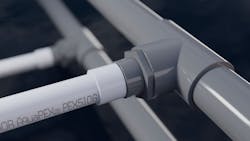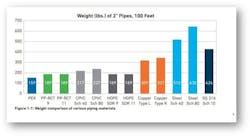Why Hybrid Piping Solutions are Shaping the Future of Commercial Plumbing
Key Highlights
- Hybrid polymer pipes combine PEX-a and Schedule 80 CPVC for corrosion resistance, chemical compatibility, and high-pressure tolerance
- They eliminate the need for welding, reducing fire hazards, injuries, and jobsite safety risks associated with traditional metal piping
- Polymer piping offers environmental benefits, including lower CO₂ emissions during production and a service life of 50-100 years, supporting sustainability goals
- The use of prefabricated kits streamlines logistics and enhances project efficiency, helping contractors meet deadlines and budgets.
For decades, metallic systems like copper and steel were the unquestioned standards. Today, industries are seeking solutions that offer long-term reliability, including corrosion resistance and design flexibility, without introducing added costs, complexity, or risk.
Over the past several decades, the plastics industry has undergone significant evolution, developing high-performance engineered polymer solutions. Engineers, contractors, and building owners are learning more about polymer piping solutions and realizing they can maximize their efficiencies while delivering building solutions that meet and exceed expectations.
Best of Both Worlds
One technology that’s rapidly gaining attention is the hybrid polymer piping system, which combines PEX-a and Schedule 80 CPVC. Together, these systems provide a cost-effective, corrosion-resistant solution that pairs the flexibility and installation efficiency of PEX with the chemical resistance and high-pressure tolerance of CPVC, providing a reliable solution for commercial applications.
One of the strongest arguments in favor of hybrid polymer piping is its durability and long-term performance. Metal piping systems are susceptible to corrosion, pitting, and scale buildup, but hybrid polymers are immune to these issues. For example, both PEX and Schedule 80 CPVC maintain a smooth internal diameter throughout the system’s life. The material does not react to metal ions or minerals, thereby eliminating scale buildup. This eliminates the need to replace building materials, such as valves, pumps, and fixtures, or anything that could become clogged or plugged in a corroded metallic system.
Schedule 80 CPVC offers a Hazen-Williams C Factor of 150; in contrast, new cast-iron systems start with a C Factor of around 120, decreasing to between 60 and 80 as the surface wears and pits. The latter results in increased friction losses and reduced system performance over time.
Lessons from the Field
Field comparisons indicate that metal piping becomes heavily corroded after years of use in wastewater or chemical applications. If a pinhole leak occurs, the scale can contaminate the water system, affecting all connected components. This situation is particularly problematic for facilities with strict water treatment protocols, such as hospitals and laboratories.
Due to its chemical compatibility, CPVC is an ideal choice for these environments. The material is tested against over 500 chemicals and compounds, including sulfuric and hydrochloric acids, sodium hydroxide, and sodium hypochlorite.
Best of all, some of these systems come with a 25-year warranty that covers both the PEX-a and the Schedule 80 CPVC pipe and fittings, as well as meet NSF, ASTM, and ICC standards for potable water, plenum applications, and overall system safety.
Safety, Speed, and Simplicity on the Jobsite
The reality is that welding accidents and injuries are common on jobsites. Welding and making solder connections with an open flame can be dangerous. Making those connections in a confined space increases the risk dramatically.
The National Fire Protection Association (NFPA) estimates there are over 4,000 structure fires per year involving equipment associated with hot work.
Unlike copper or steel, hybrid PEX-a and Schedule 80 CPVC systems do not require open flames, soldering, or welding. That means no fire watches and no need for a fire permit, which is beneficial from both cost and safety perspectives.
Polymer pipes are also significantly lighter than metal pipes, reducing physical strain and the risk of injury. This is increasingly important in a trade in which the average age of a worker is 50 years. Lightweight materials not only make handling safer but also enable smaller crews to complete installations more quickly.
The weight difference between the types of pipes used on the jobsite affects both safety and productivity. For example, on a 2-inch diameter pipe over a 100-foot length, PEX weighs only 159 pounds, and Schedule 80 CPVC weighs 227 pounds. Compare that with steel pipe, which is significantly heavier, ranging between 500 and 650 pounds, depending on the type of steel.
Contractors have also reported measurable efficiency gains through the use of prefabrication and kitting. On average, a jobsite can achieve a labor savings range of 15%-45%, depending on the specific materials, fitting connections, and application.
Prepackaged material kits streamline logistics by including all the fittings, adapters, and rings needed for specific assemblies. This helps crews work more efficiently and stay focused on their tasks, while also reducing downtime spent managing materials.
In all, kitting supports steady progress toward successful project completion.
Environmental Efficiency and Long-Term Performance
Sustainability has not yet become the highest priority on every jobsite, but the industry is rapidly moving in that direction. Hybrid polymer systems are helping drive this shift by offering long-term performance with reduced environmental impact.
The US Environmental Protection Agency defines life cycle assessment (LCA) as a comprehensive method for evaluating the environmental effects of a product throughout its entire life cycle. Studies show that compared with copper, the production of PEX generates 42% fewer CO₂ emissions and contains 47% less embodied carbon.
Because PEX is up to 80% lighter than copper or steel, it also supports lower transportation costs and reduces emissions associated with delivery and handling. Additionally, with an expected service life of 50 to 100 years, PEX reduces the need for replacement, further extending the sustainability benefits. Its lower thermal conductivity compared with metal piping minimizes heat loss, reducing the need for recirculation and saving both water and energy.
Where the Industry is Headed
Hybrid systems aren’t just a new material choice; they’re a new way to think about plumbing and mechanical design. They reflect where the industry is headed: safer jobsites, longer-lasting systems, and smarter solutions that let contractors focus on what matters most—delivering quality work on time and on budget.
About the Author
Brian Bollenbeck
Brian Bollenbeck is the product manager for Hot and Cold Water Supply at GF Building Flow Solutions. With more than 13 years in the industry, he has held several positions supporting engineers, contractors, and installers in plumbing and HVAC. He began his career as a radiant heating and cooling designer before transitioning to technical services support, portfolio management, and plumbing product management. He has a Bachelor of Arts in Organizational Leadership Management from Concordia University in St. Paul, Minn., and is a professional member of the American Society of Plumbing Engineers (ASPE).

